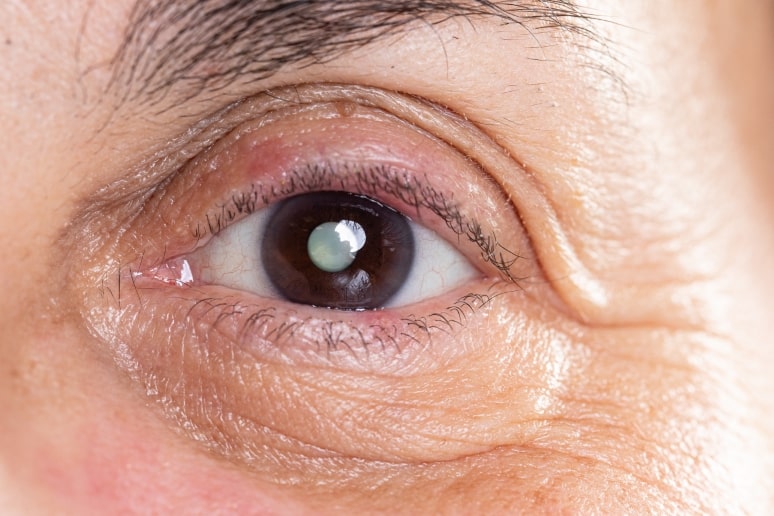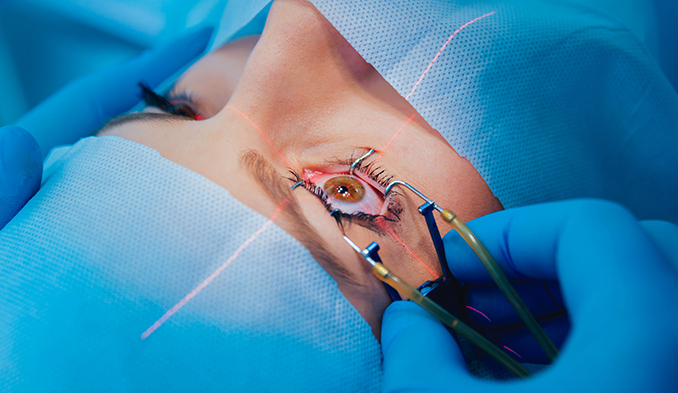Cataract is a disease known to mankind since ancient times. The ancient Hellenes called it "cataract", which translated means "waterfall". The name comes from the sensation that results from the darkening of the eye lens, as if you were seeing through a waterfall.
What is a cataract?
A cataract is a blurring of the clear lens of the eye. When a cataract develops the eye cannot focus light as it used to and this causes blurring of vision. The change in vision depends on the location and size of the cataract.
What are the types of cataracts?
There are many types of cataracts. Most are caused by a change in the chemical composition of the lens, resulting in a loss of its transparency. These changes can be caused by aging, injury, certain diseases and conditions of the eye, certain medications (especially steroids), and inherited or birth defects. The most common is senile cataract, which occurs as a result of the normal aging process. Sometimes cataracts can be hereditary. It can be caused by infection or inflammation during pregnancy. This type of cataract is called congenital. Injuries to the eye can cause cataracts in people of any age- a severe blow, puncture, cut, chemical burn or very strong heat can damage the lens and end in what is called a traumatic cataract.
Senile cataract
Senile cataract is an age-related disease that worsens vision and is characterized by gradual progressive clouding and thickening of the lens of the eye. It is the world's leading cause of treatable blindness. Most people begin to get cataracts around the age of 40. But they probably won't notice symptoms until after age 60.
If the cataract is located on the periphery of the lens, there may be no change in vision. If the blurring is near the center of the lens, it usually reduces the clarity of vision. Common symptoms in the development of cataract include blurred vision, sensitivity to light and glare, double vision, less perception of color saturation. The pupil, which normally appears black, may undergo noticeable color changes and appear yellowish or white.
Is it time for surgery?
When a cataract is causing vision loss affecting a person's ability to perform daily activities, it is probably already time to have it removed. Depending on individual needs, the patient and the ophthalmologist together decide when it is time for the surgery.
Surgical intervention is the only effective way to remove a cataract of the eye.
Cataract surgery is extremely reliable and has a high success rate- over 90% of patients who undergo surgery regain their vision. After the clouded natural lens of the eye is removed, the patient needs a replacement lens to allow the eye to focus again.
Intraocular lenses are artificial lenses that replace the natural lens removed during cataract surgery. There are different types of lenses:
- Monofocal - allow focusing at only one distance - far. For reading or computer work the patient will need glasses.
- Multifocal - this type of lenses allow all ranges of vision near, medium and far. The lenses work by using several different optical powers at different points in the lens. They work best if implanted in both eyes.
- Lenses correcting astigmatism - recommended for patients with cataracts and astigmatism. Like monofocal lenses, this type of lens provides distance vision with less dependence on glasses.
- Multifocal toric lenses - for patients with astigmatism who do not want to wear glasses for near and far, whether they have cataracts or not. They can replace the natural human lens and correct presbyopia, giving visual acuity at all distances - near, intermediate and far.
Which lens is most appropriate is decided by the patient and the eye doctor, who takes into account the patient's lifestyle, diagnosis and wishes.
What to expect during surgery?
Cataract surgery is usually an outpatient procedure and takes about 20 minutes for each eye. It can be done for both eyes at the same time or on two consecutive days if the patient would feel more comfortable. Drops are first placed in the eye to dilate the pupil. It is performed with local anesthesia. If the patient wishes a sedative may be given to relax them. During surgery, the clouded lens is removed by a procedure called phacoemulsification. A small incision is made in the front of the eye and a needle-thin probe is inserted to transmit ultrasound waves to break up the cataract and suck out the fragments. The back of the lens is left intact to serve as the insertion site for the new artificial lens. Once the cataract is removed, the new lens is implanted into the empty capsule. No sutures are used.
If the cataract is very advanced and too dense to break up easily another technique may be necessary- extracapsular cataract surgery. This involves making a larger opening in the eye. Instead of breaking the lens and removing it, it is removed as one large piece. Stitches may need to be placed.
After surgery, vision may be blurry but will improve within a few days while the eye heals and adjusts. Colors may appear brighter because the lens is new and clear. The cataract is usually yellow tinted before surgery and mutes the strength of the colors.
Follow-up examination is done the next day, after a week and after a month to monitor healing.
Eye drops or other medications to prevent infection, reduce inflammation and control eye pressure will be prescribed. Full recovery is within eight weeks.
Is cataract surgery safe?
Cataract surgery is one of the safest. The likelihood of complications is extremely low. But there are always some risks. Some people experience infection or vision loss after the procedure.
How painful is cataract surgery?
No pain is felt during cataract surgery. After surgery, there may be some discomfort, itching, and irritation from light.
Congenital cataract
Congenital cataract is a darkening of the natural lens of the eye that occurs at birth.
Depending on the density and location of the blur, congenital cataracts may need to be removed through cataract surgery while the child is still an infant to allow for normal vision development and prevent amblyopia and even blindness.
Congenital cataracts can occur in newborn babies for many reasons, including hereditary tendencies, infection, metabolic problems, diabetes, trauma, inflammation, or drug reactions.
As an example, tetracycline antibiotics used to treat infections in pregnant women have been shown to cause cataracts in newborn babies.
Congenital cataracts can also occur when the mother develops infections such as measles or rubella (the most common cause), chickenpox, cytomegalovirus, herpes simplex, herpes zoster, polio, influenza, Epstein-Barr virus, syphilis, and toxoplasmosis during pregnancy.
Without early intervention, congenital cataracts cause "lazy eye" or amblyopia. This condition can lead to other eye problems such as nystagmus, strabismus, and the inability to fix one's gaze on objects. Such problems can profoundly affect a child's learning ability, personality, and even appearance, ultimately affecting their entire life.
The only treatment for congenital cataracts is cataract surgery. If a child has a congenital cataract in only one eye, surgery is absolutely necessary and should be done in a timely manner. In case of congenital cataract of both eyes the condition can be monitored and the best decision can be taken.
Once the cataract is removed, it is very important that the child's eye is corrected with a surgically implanted intraocular lens, contact lens or glasses. Without vision correction after cataract surgery, the eye will have poor vision and the child's normal vision development will be hindered.
Opinions differ on whether an artificial lens should be surgically placed in a child's eye after cataract surgery because of concerns that the normal growth and development of the eye may be affected. The lens may also need to be removed and replaced as the child grows due to possible changes in vision.
In some cases, contact lenses placed on the surface of the eye can be used to restore vision after the natural lens is removed during cataract surgery. Also, eyeglasses may be prescribed to aid vision instead of an artificial lens or contact lens being inserted.
If the eye surgeon recommends contact lenses after congenital cataract surgery, long-wear contact lenses will usually be prescribed to simplify lens care and handling.
The only way to know for sure if a young child's eyes are healthy and developing normally is to schedule an eye exam in infancy, when the child is 6 months old.
Traumatic cataract
Traumatic cataract is a clouding of the lens and eye that can occur after blunt or penetrating eye trauma that destroys and damages the lens fibers. Most traumatic cataracts result in swelling of the eye lens, but the type and clinical course depend on the trauma and the integrity of the capsular bag.
Similar to the clouding of the lens caused by other factors, traumatic cataracts cause blurred vision. They can also cause pain or discomfort, redness of the eye, corneal infection and swelling.
Traumatic cataract in early childhood must necessarily be operated.
Because the young child's vision is still developing, a traumatic cataract can cause the vision in the injured eye to lag behind, leading to amblyopia or "lazy eye." Removal of the cataract is imperative as soon as possible.
Don't let cataracts change the way you see the world!
Contact ZIC "Medical Karaj" at tel. 0879 977 402 for consultation and detailed information!




